The Impact of Big Data and AI on Decision-Making Efficiency Analysis
VerifiedAdded on 2022/09/27
|11
|2661
|117
Report
AI Summary
This report investigates the efficiency of decision-making processes as influenced by big data and artificial intelligence. The research, based on literature review and a mixed methodology, examines how organizations leverage AI and big data to enhance strategic decision-making and improve operational and financial performance. Findings reveal that big data and AI are perceived to significantly improve organizational efficiency, strategic planning, and the credibility of decision-making sources. The study also highlights the challenges of implementation, such as high costs and the need for skilled manpower. The report concludes by summarizing the impact of big data and AI on decision-making, competitive advantage, and financial and operational improvements, along with potential challenges and opportunities. The research emphasizes the importance of these technologies across various sectors and their role in optimizing resources and maximizing profits.

Running Head: Chapter 4 and 5 1
Student Name:
Student ID:
Lecturer:
Unit Coordinator:
University:
Student Name:
Student ID:
Lecturer:
Unit Coordinator:
University:
Paraphrase This Document
Need a fresh take? Get an instant paraphrase of this document with our AI Paraphraser
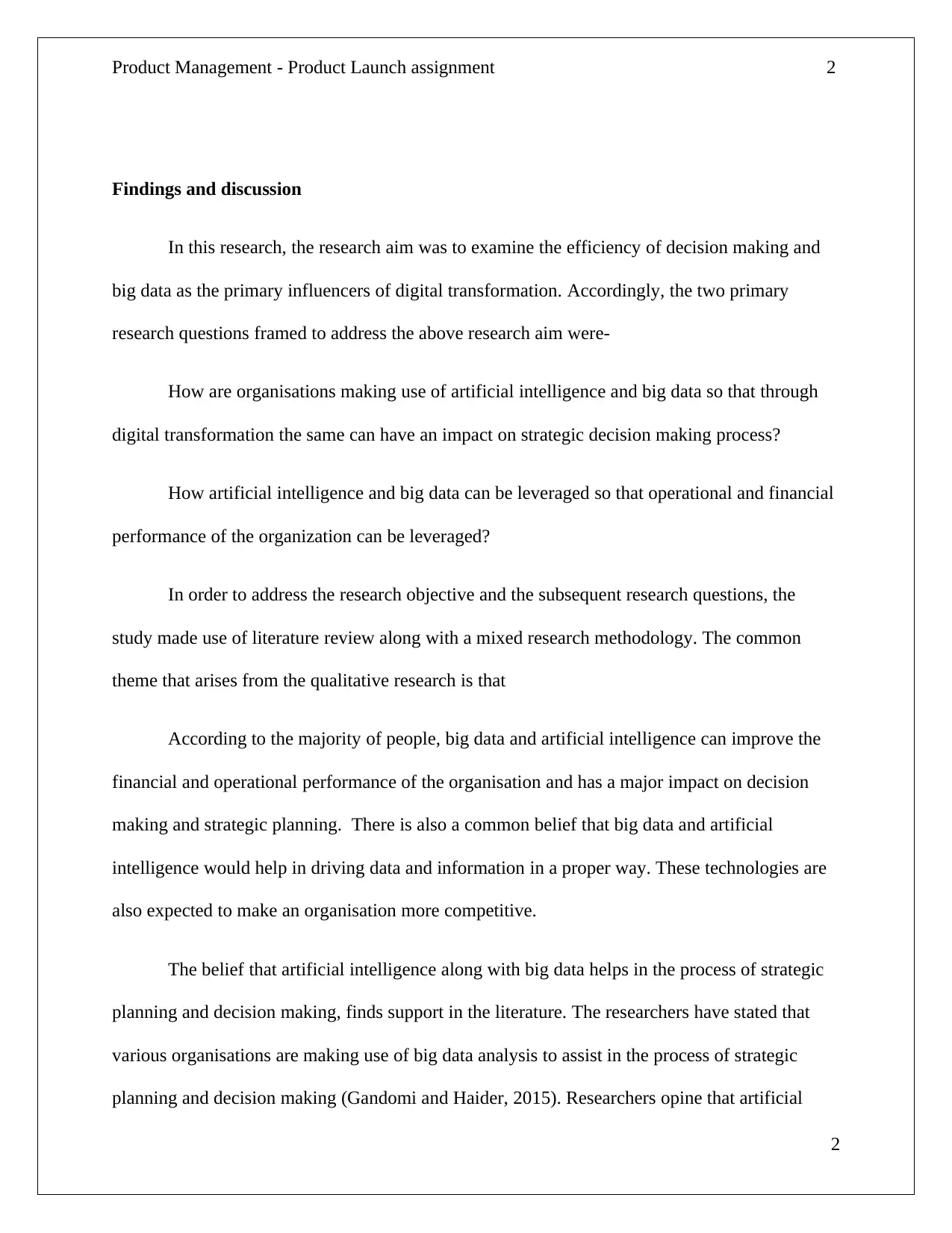
Product Management - Product Launch assignment 2
Findings and discussion
In this research, the research aim was to examine the efficiency of decision making and
big data as the primary influencers of digital transformation. Accordingly, the two primary
research questions framed to address the above research aim were-
How are organisations making use of artificial intelligence and big data so that through
digital transformation the same can have an impact on strategic decision making process?
How artificial intelligence and big data can be leveraged so that operational and financial
performance of the organization can be leveraged?
In order to address the research objective and the subsequent research questions, the
study made use of literature review along with a mixed research methodology. The common
theme that arises from the qualitative research is that
According to the majority of people, big data and artificial intelligence can improve the
financial and operational performance of the organisation and has a major impact on decision
making and strategic planning. There is also a common belief that big data and artificial
intelligence would help in driving data and information in a proper way. These technologies are
also expected to make an organisation more competitive.
The belief that artificial intelligence along with big data helps in the process of strategic
planning and decision making, finds support in the literature. The researchers have stated that
various organisations are making use of big data analysis to assist in the process of strategic
planning and decision making (Gandomi and Haider, 2015). Researchers opine that artificial
2
Findings and discussion
In this research, the research aim was to examine the efficiency of decision making and
big data as the primary influencers of digital transformation. Accordingly, the two primary
research questions framed to address the above research aim were-
How are organisations making use of artificial intelligence and big data so that through
digital transformation the same can have an impact on strategic decision making process?
How artificial intelligence and big data can be leveraged so that operational and financial
performance of the organization can be leveraged?
In order to address the research objective and the subsequent research questions, the
study made use of literature review along with a mixed research methodology. The common
theme that arises from the qualitative research is that
According to the majority of people, big data and artificial intelligence can improve the
financial and operational performance of the organisation and has a major impact on decision
making and strategic planning. There is also a common belief that big data and artificial
intelligence would help in driving data and information in a proper way. These technologies are
also expected to make an organisation more competitive.
The belief that artificial intelligence along with big data helps in the process of strategic
planning and decision making, finds support in the literature. The researchers have stated that
various organisations are making use of big data analysis to assist in the process of strategic
planning and decision making (Gandomi and Haider, 2015). Researchers opine that artificial
2
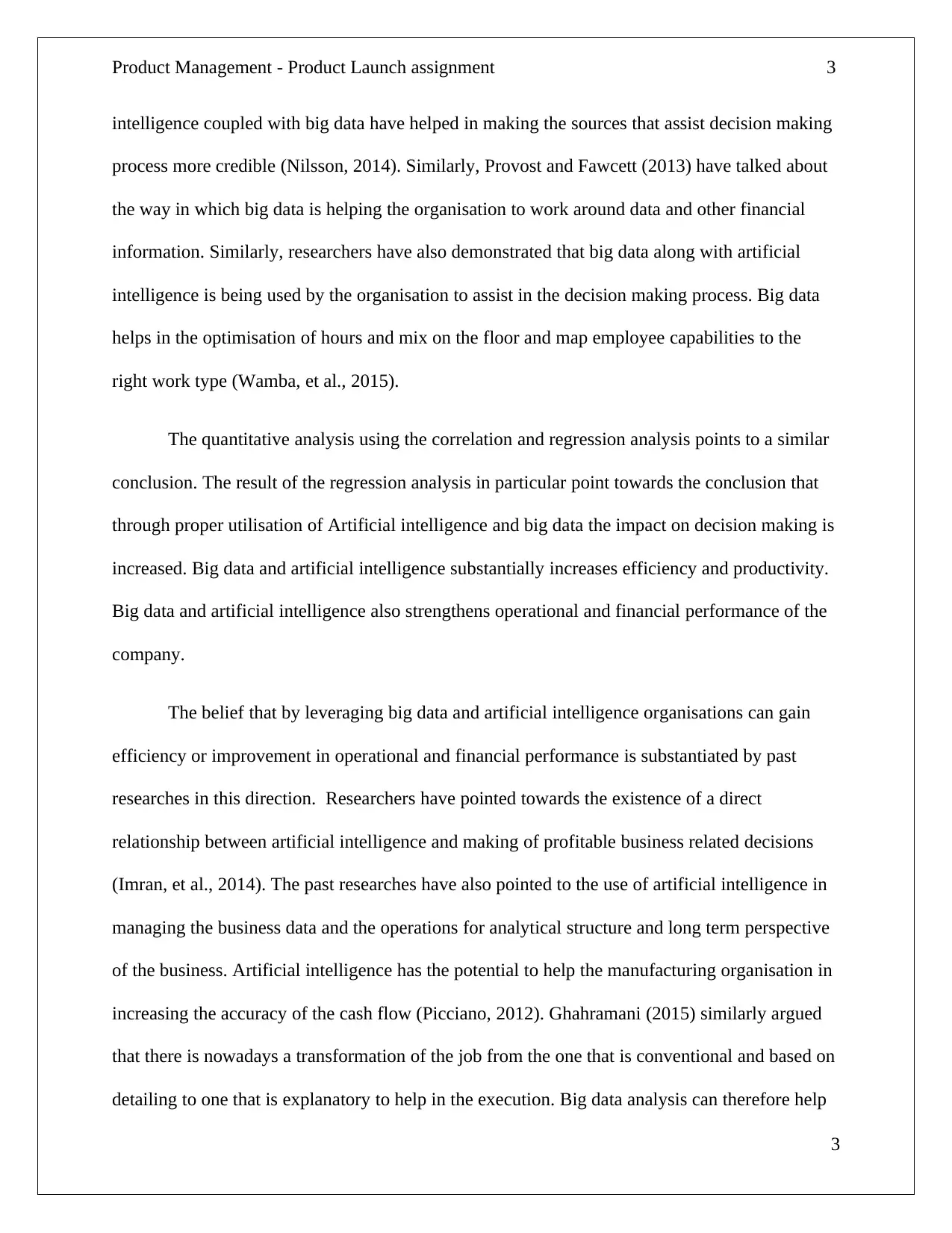
Product Management - Product Launch assignment 3
intelligence coupled with big data have helped in making the sources that assist decision making
process more credible (Nilsson, 2014). Similarly, Provost and Fawcett (2013) have talked about
the way in which big data is helping the organisation to work around data and other financial
information. Similarly, researchers have also demonstrated that big data along with artificial
intelligence is being used by the organisation to assist in the decision making process. Big data
helps in the optimisation of hours and mix on the floor and map employee capabilities to the
right work type (Wamba, et al., 2015).
The quantitative analysis using the correlation and regression analysis points to a similar
conclusion. The result of the regression analysis in particular point towards the conclusion that
through proper utilisation of Artificial intelligence and big data the impact on decision making is
increased. Big data and artificial intelligence substantially increases efficiency and productivity.
Big data and artificial intelligence also strengthens operational and financial performance of the
company.
The belief that by leveraging big data and artificial intelligence organisations can gain
efficiency or improvement in operational and financial performance is substantiated by past
researches in this direction. Researchers have pointed towards the existence of a direct
relationship between artificial intelligence and making of profitable business related decisions
(Imran, et al., 2014). The past researches have also pointed to the use of artificial intelligence in
managing the business data and the operations for analytical structure and long term perspective
of the business. Artificial intelligence has the potential to help the manufacturing organisation in
increasing the accuracy of the cash flow (Picciano, 2012). Ghahramani (2015) similarly argued
that there is nowadays a transformation of the job from the one that is conventional and based on
detailing to one that is explanatory to help in the execution. Big data analysis can therefore help
3
intelligence coupled with big data have helped in making the sources that assist decision making
process more credible (Nilsson, 2014). Similarly, Provost and Fawcett (2013) have talked about
the way in which big data is helping the organisation to work around data and other financial
information. Similarly, researchers have also demonstrated that big data along with artificial
intelligence is being used by the organisation to assist in the decision making process. Big data
helps in the optimisation of hours and mix on the floor and map employee capabilities to the
right work type (Wamba, et al., 2015).
The quantitative analysis using the correlation and regression analysis points to a similar
conclusion. The result of the regression analysis in particular point towards the conclusion that
through proper utilisation of Artificial intelligence and big data the impact on decision making is
increased. Big data and artificial intelligence substantially increases efficiency and productivity.
Big data and artificial intelligence also strengthens operational and financial performance of the
company.
The belief that by leveraging big data and artificial intelligence organisations can gain
efficiency or improvement in operational and financial performance is substantiated by past
researches in this direction. Researchers have pointed towards the existence of a direct
relationship between artificial intelligence and making of profitable business related decisions
(Imran, et al., 2014). The past researches have also pointed to the use of artificial intelligence in
managing the business data and the operations for analytical structure and long term perspective
of the business. Artificial intelligence has the potential to help the manufacturing organisation in
increasing the accuracy of the cash flow (Picciano, 2012). Ghahramani (2015) similarly argued
that there is nowadays a transformation of the job from the one that is conventional and based on
detailing to one that is explanatory to help in the execution. Big data analysis can therefore help
3
⊘ This is a preview!⊘
Do you want full access?
Subscribe today to unlock all pages.

Trusted by 1+ million students worldwide
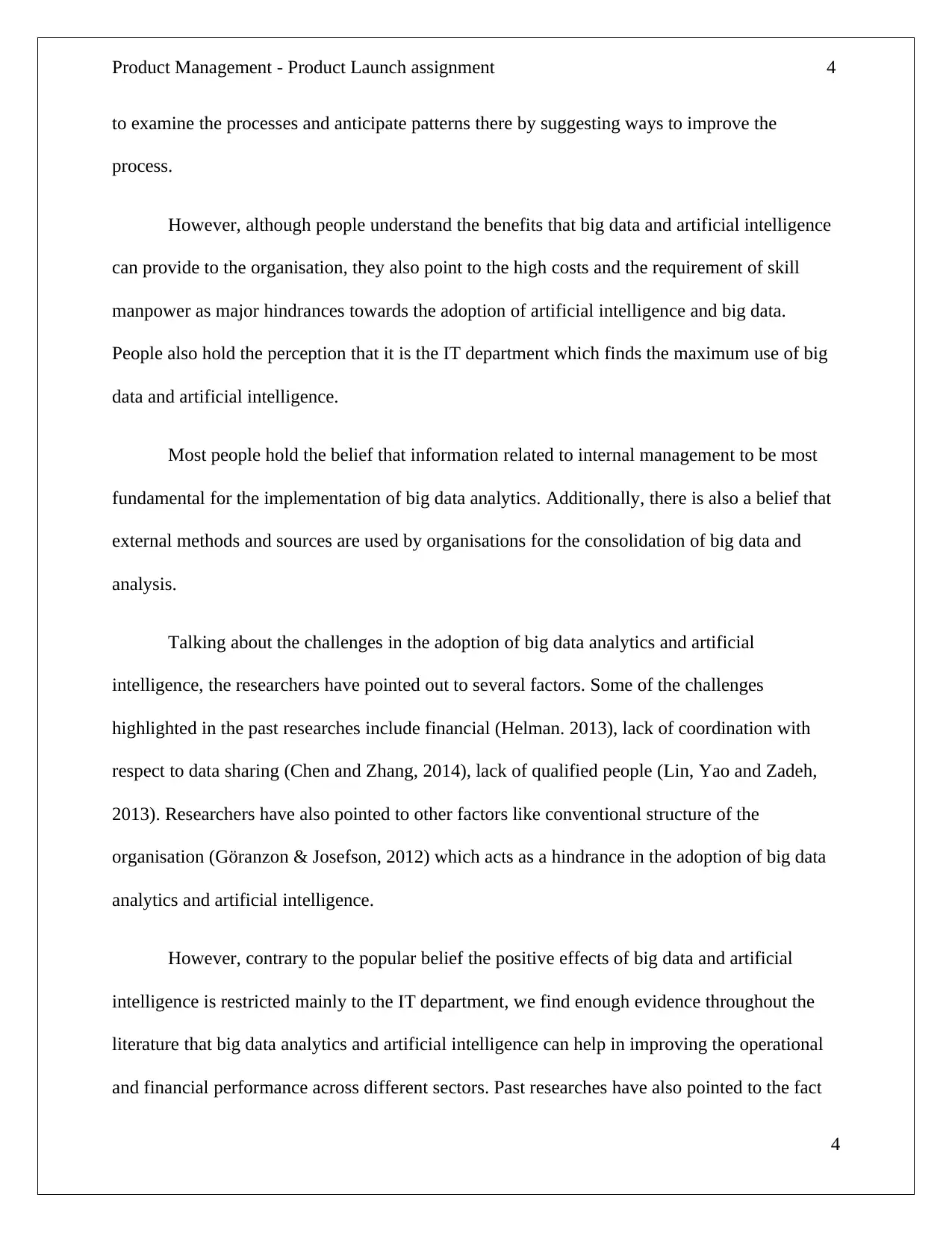
Product Management - Product Launch assignment 4
to examine the processes and anticipate patterns there by suggesting ways to improve the
process.
However, although people understand the benefits that big data and artificial intelligence
can provide to the organisation, they also point to the high costs and the requirement of skill
manpower as major hindrances towards the adoption of artificial intelligence and big data.
People also hold the perception that it is the IT department which finds the maximum use of big
data and artificial intelligence.
Most people hold the belief that information related to internal management to be most
fundamental for the implementation of big data analytics. Additionally, there is also a belief that
external methods and sources are used by organisations for the consolidation of big data and
analysis.
Talking about the challenges in the adoption of big data analytics and artificial
intelligence, the researchers have pointed out to several factors. Some of the challenges
highlighted in the past researches include financial (Helman. 2013), lack of coordination with
respect to data sharing (Chen and Zhang, 2014), lack of qualified people (Lin, Yao and Zadeh,
2013). Researchers have also pointed to other factors like conventional structure of the
organisation (Göranzon & Josefson, 2012) which acts as a hindrance in the adoption of big data
analytics and artificial intelligence.
However, contrary to the popular belief the positive effects of big data and artificial
intelligence is restricted mainly to the IT department, we find enough evidence throughout the
literature that big data analytics and artificial intelligence can help in improving the operational
and financial performance across different sectors. Past researches have also pointed to the fact
4
to examine the processes and anticipate patterns there by suggesting ways to improve the
process.
However, although people understand the benefits that big data and artificial intelligence
can provide to the organisation, they also point to the high costs and the requirement of skill
manpower as major hindrances towards the adoption of artificial intelligence and big data.
People also hold the perception that it is the IT department which finds the maximum use of big
data and artificial intelligence.
Most people hold the belief that information related to internal management to be most
fundamental for the implementation of big data analytics. Additionally, there is also a belief that
external methods and sources are used by organisations for the consolidation of big data and
analysis.
Talking about the challenges in the adoption of big data analytics and artificial
intelligence, the researchers have pointed out to several factors. Some of the challenges
highlighted in the past researches include financial (Helman. 2013), lack of coordination with
respect to data sharing (Chen and Zhang, 2014), lack of qualified people (Lin, Yao and Zadeh,
2013). Researchers have also pointed to other factors like conventional structure of the
organisation (Göranzon & Josefson, 2012) which acts as a hindrance in the adoption of big data
analytics and artificial intelligence.
However, contrary to the popular belief the positive effects of big data and artificial
intelligence is restricted mainly to the IT department, we find enough evidence throughout the
literature that big data analytics and artificial intelligence can help in improving the operational
and financial performance across different sectors. Past researches have also pointed to the fact
4
Paraphrase This Document
Need a fresh take? Get an instant paraphrase of this document with our AI Paraphraser

Product Management - Product Launch assignment 5
that artificial intelligence and big data analytics helps in decision making across the entire
spectrum of organisation.
For instance Researchers have pointed to the extensive use of big data and artificial
intelligence in the manufacturing industry (Dhar, 2013; Cohen and Fiengenbaum, 2014) in the
retail industry (Hashem, 2015; Klassen and Vereecke, 2012) and the financial industry (Popkin,
Adair and Ng, 2012, Fallon, et al., 2015). Among the other usage of big data analytics the
researchers have pointed towards the fact that the big data analytics can help in maximising
profits and optimising resources and thus help the decision makers (Ribeiro, 2006).
Conclusion
The main aim of the research was to understand the impact of big data analytics and
artificial intelligence in the areas of decision making and strategic planning. In this research the
main research objectives that were designed to address the research aim are listed below. Below
each of the research objective, the findings from the literature review and primary research are
summarized so as to address the research objective.
Objective 1
Identifying the way in which big data and artificial intelligence driven data is being used
by organisation to bring more efficiency in the decision making process and also helping in
strategic planning.
Qualitative analysis of survey responses demonstrated that most people believe in
the potential help offered by big data analysis and artificial intelligence in the strategic planning
and decision making domains. The same belief is resonated by the evidences of past literatures
5
that artificial intelligence and big data analytics helps in decision making across the entire
spectrum of organisation.
For instance Researchers have pointed to the extensive use of big data and artificial
intelligence in the manufacturing industry (Dhar, 2013; Cohen and Fiengenbaum, 2014) in the
retail industry (Hashem, 2015; Klassen and Vereecke, 2012) and the financial industry (Popkin,
Adair and Ng, 2012, Fallon, et al., 2015). Among the other usage of big data analytics the
researchers have pointed towards the fact that the big data analytics can help in maximising
profits and optimising resources and thus help the decision makers (Ribeiro, 2006).
Conclusion
The main aim of the research was to understand the impact of big data analytics and
artificial intelligence in the areas of decision making and strategic planning. In this research the
main research objectives that were designed to address the research aim are listed below. Below
each of the research objective, the findings from the literature review and primary research are
summarized so as to address the research objective.
Objective 1
Identifying the way in which big data and artificial intelligence driven data is being used
by organisation to bring more efficiency in the decision making process and also helping in
strategic planning.
Qualitative analysis of survey responses demonstrated that most people believe in
the potential help offered by big data analysis and artificial intelligence in the strategic planning
and decision making domains. The same belief is resonated by the evidences of past literatures
5
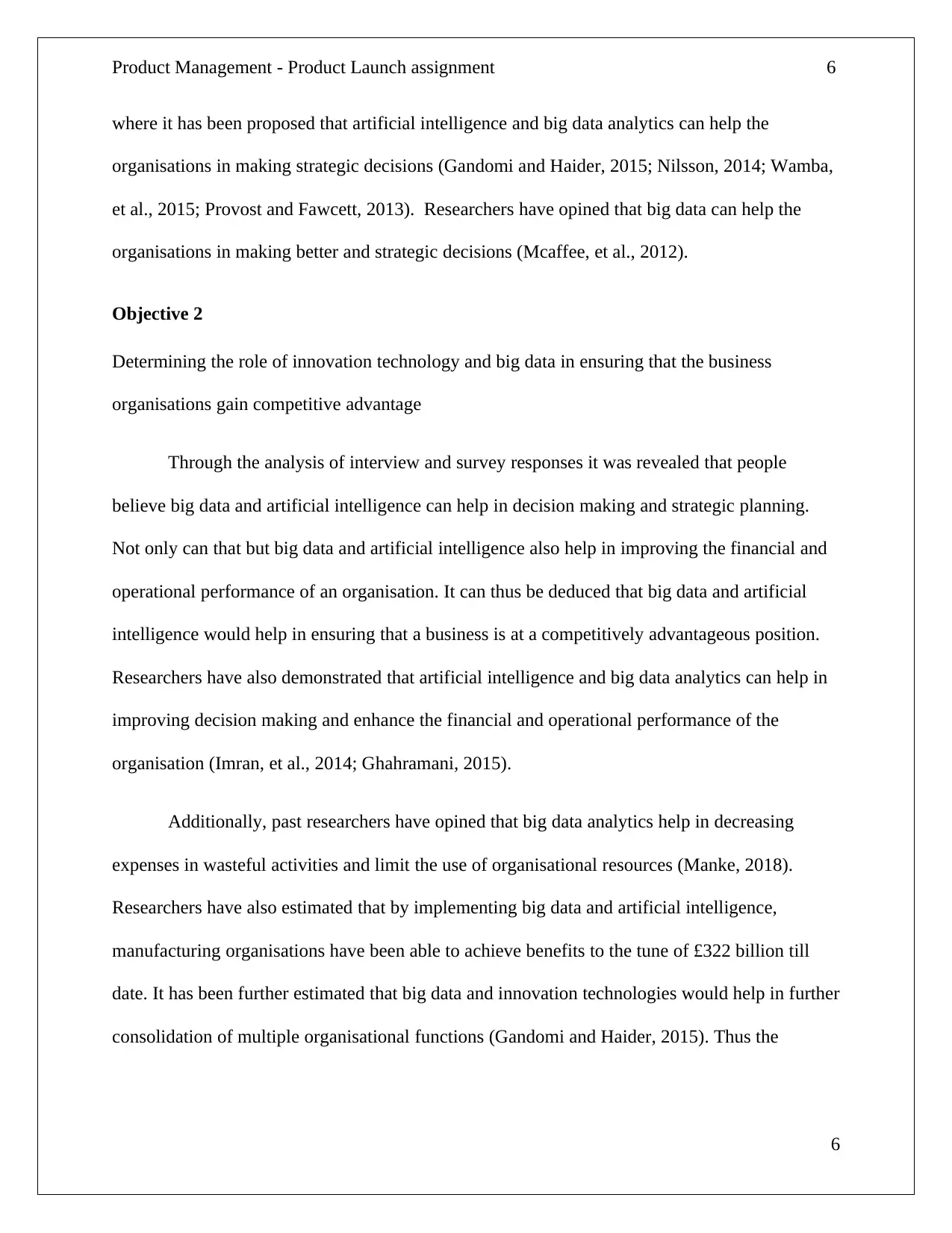
Product Management - Product Launch assignment 6
where it has been proposed that artificial intelligence and big data analytics can help the
organisations in making strategic decisions (Gandomi and Haider, 2015; Nilsson, 2014; Wamba,
et al., 2015; Provost and Fawcett, 2013). Researchers have opined that big data can help the
organisations in making better and strategic decisions (Mcaffee, et al., 2012).
Objective 2
Determining the role of innovation technology and big data in ensuring that the business
organisations gain competitive advantage
Through the analysis of interview and survey responses it was revealed that people
believe big data and artificial intelligence can help in decision making and strategic planning.
Not only can that but big data and artificial intelligence also help in improving the financial and
operational performance of an organisation. It can thus be deduced that big data and artificial
intelligence would help in ensuring that a business is at a competitively advantageous position.
Researchers have also demonstrated that artificial intelligence and big data analytics can help in
improving decision making and enhance the financial and operational performance of the
organisation (Imran, et al., 2014; Ghahramani, 2015).
Additionally, past researchers have opined that big data analytics help in decreasing
expenses in wasteful activities and limit the use of organisational resources (Manke, 2018).
Researchers have also estimated that by implementing big data and artificial intelligence,
manufacturing organisations have been able to achieve benefits to the tune of £322 billion till
date. It has been further estimated that big data and innovation technologies would help in further
consolidation of multiple organisational functions (Gandomi and Haider, 2015). Thus the
6
where it has been proposed that artificial intelligence and big data analytics can help the
organisations in making strategic decisions (Gandomi and Haider, 2015; Nilsson, 2014; Wamba,
et al., 2015; Provost and Fawcett, 2013). Researchers have opined that big data can help the
organisations in making better and strategic decisions (Mcaffee, et al., 2012).
Objective 2
Determining the role of innovation technology and big data in ensuring that the business
organisations gain competitive advantage
Through the analysis of interview and survey responses it was revealed that people
believe big data and artificial intelligence can help in decision making and strategic planning.
Not only can that but big data and artificial intelligence also help in improving the financial and
operational performance of an organisation. It can thus be deduced that big data and artificial
intelligence would help in ensuring that a business is at a competitively advantageous position.
Researchers have also demonstrated that artificial intelligence and big data analytics can help in
improving decision making and enhance the financial and operational performance of the
organisation (Imran, et al., 2014; Ghahramani, 2015).
Additionally, past researchers have opined that big data analytics help in decreasing
expenses in wasteful activities and limit the use of organisational resources (Manke, 2018).
Researchers have also estimated that by implementing big data and artificial intelligence,
manufacturing organisations have been able to achieve benefits to the tune of £322 billion till
date. It has been further estimated that big data and innovation technologies would help in further
consolidation of multiple organisational functions (Gandomi and Haider, 2015). Thus the
6
⊘ This is a preview!⊘
Do you want full access?
Subscribe today to unlock all pages.

Trusted by 1+ million students worldwide
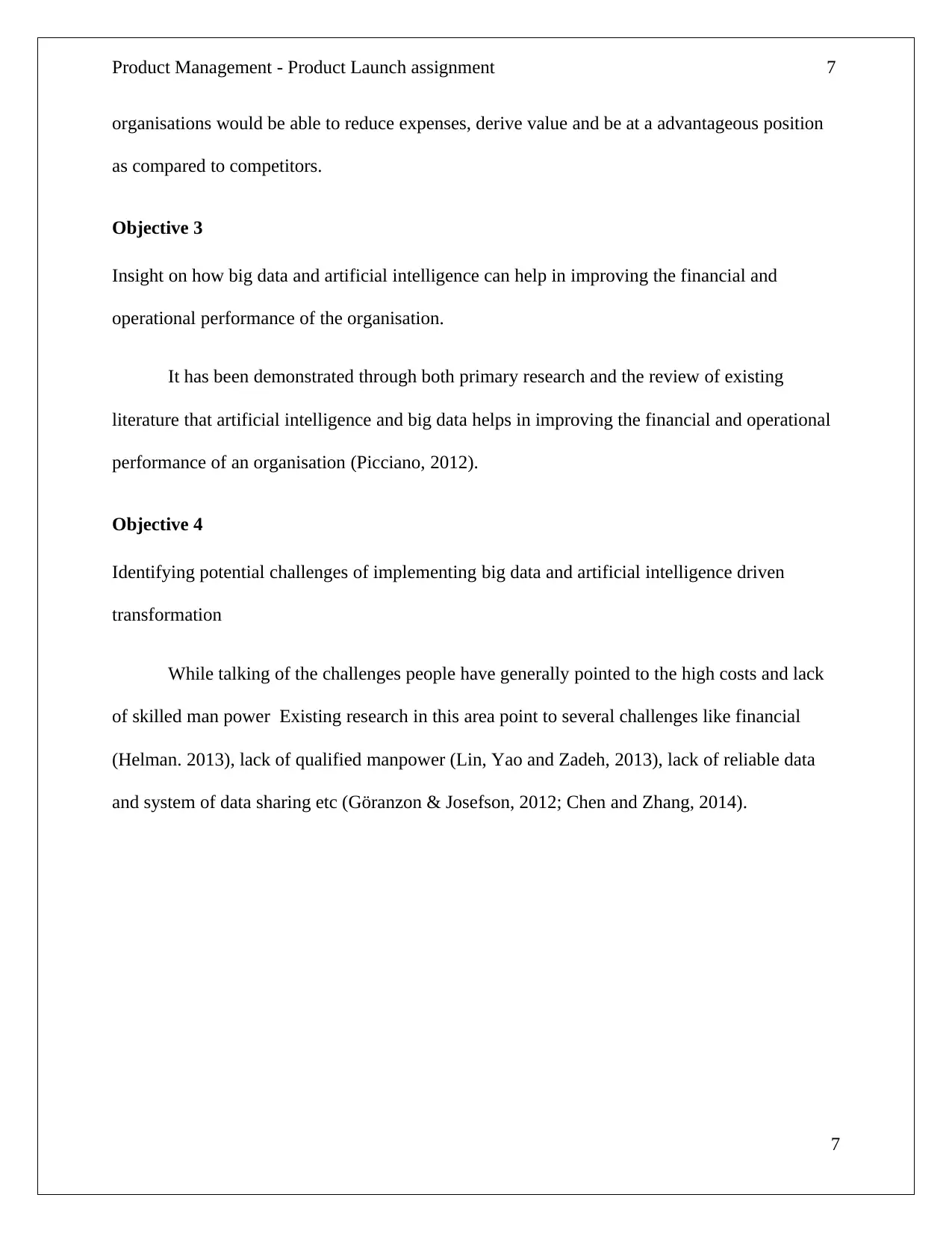
Product Management - Product Launch assignment 7
organisations would be able to reduce expenses, derive value and be at a advantageous position
as compared to competitors.
Objective 3
Insight on how big data and artificial intelligence can help in improving the financial and
operational performance of the organisation.
It has been demonstrated through both primary research and the review of existing
literature that artificial intelligence and big data helps in improving the financial and operational
performance of an organisation (Picciano, 2012).
Objective 4
Identifying potential challenges of implementing big data and artificial intelligence driven
transformation
While talking of the challenges people have generally pointed to the high costs and lack
of skilled man power Existing research in this area point to several challenges like financial
(Helman. 2013), lack of qualified manpower (Lin, Yao and Zadeh, 2013), lack of reliable data
and system of data sharing etc (Göranzon & Josefson, 2012; Chen and Zhang, 2014).
7
organisations would be able to reduce expenses, derive value and be at a advantageous position
as compared to competitors.
Objective 3
Insight on how big data and artificial intelligence can help in improving the financial and
operational performance of the organisation.
It has been demonstrated through both primary research and the review of existing
literature that artificial intelligence and big data helps in improving the financial and operational
performance of an organisation (Picciano, 2012).
Objective 4
Identifying potential challenges of implementing big data and artificial intelligence driven
transformation
While talking of the challenges people have generally pointed to the high costs and lack
of skilled man power Existing research in this area point to several challenges like financial
(Helman. 2013), lack of qualified manpower (Lin, Yao and Zadeh, 2013), lack of reliable data
and system of data sharing etc (Göranzon & Josefson, 2012; Chen and Zhang, 2014).
7
Paraphrase This Document
Need a fresh take? Get an instant paraphrase of this document with our AI Paraphraser
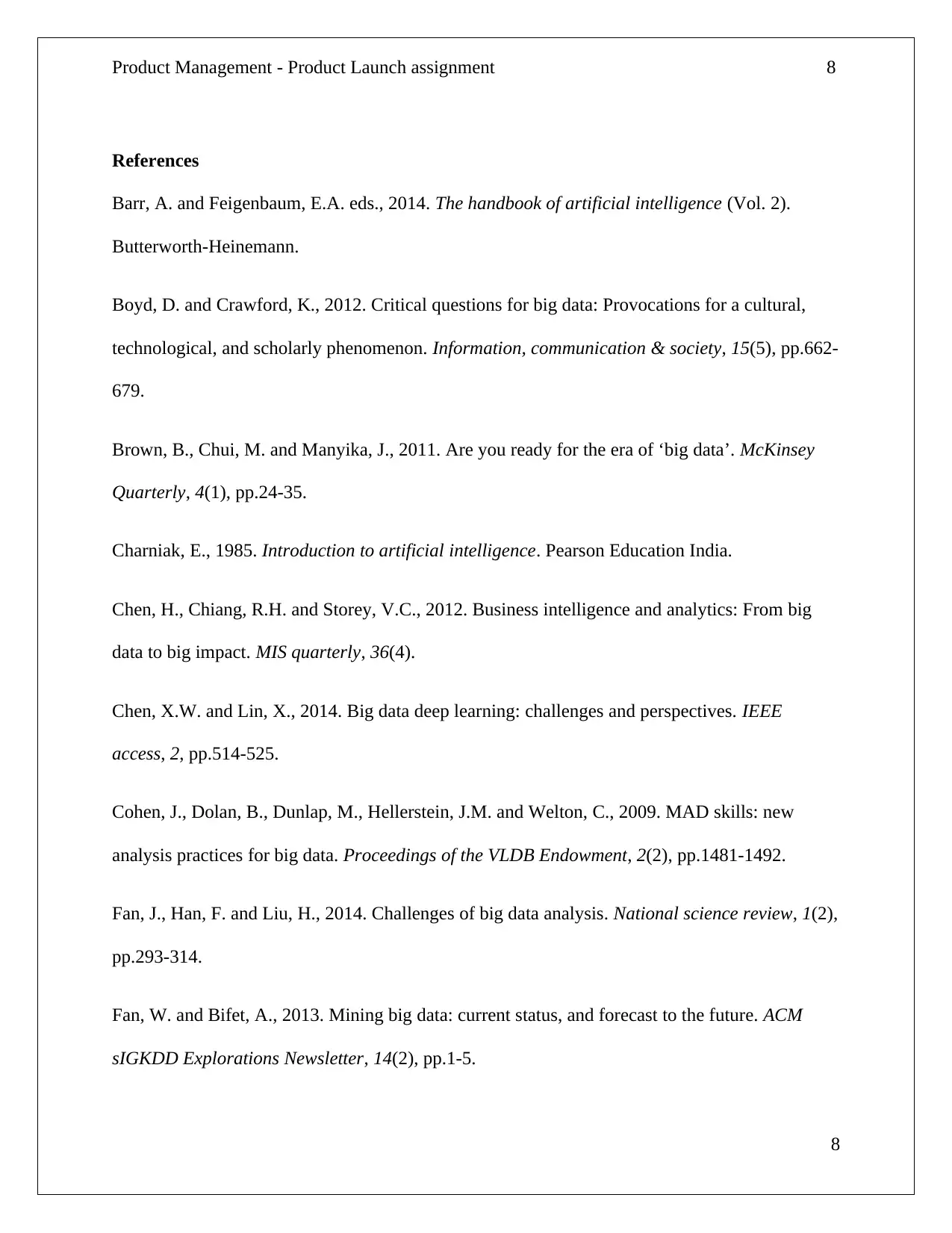
Product Management - Product Launch assignment 8
References
Barr, A. and Feigenbaum, E.A. eds., 2014. The handbook of artificial intelligence (Vol. 2).
Butterworth-Heinemann.
Boyd, D. and Crawford, K., 2012. Critical questions for big data: Provocations for a cultural,
technological, and scholarly phenomenon. Information, communication & society, 15(5), pp.662-
679.
Brown, B., Chui, M. and Manyika, J., 2011. Are you ready for the era of ‘big data’. McKinsey
Quarterly, 4(1), pp.24-35.
Charniak, E., 1985. Introduction to artificial intelligence. Pearson Education India.
Chen, H., Chiang, R.H. and Storey, V.C., 2012. Business intelligence and analytics: From big
data to big impact. MIS quarterly, 36(4).
Chen, X.W. and Lin, X., 2014. Big data deep learning: challenges and perspectives. IEEE
access, 2, pp.514-525.
Cohen, J., Dolan, B., Dunlap, M., Hellerstein, J.M. and Welton, C., 2009. MAD skills: new
analysis practices for big data. Proceedings of the VLDB Endowment, 2(2), pp.1481-1492.
Fan, J., Han, F. and Liu, H., 2014. Challenges of big data analysis. National science review, 1(2),
pp.293-314.
Fan, W. and Bifet, A., 2013. Mining big data: current status, and forecast to the future. ACM
sIGKDD Explorations Newsletter, 14(2), pp.1-5.
8
References
Barr, A. and Feigenbaum, E.A. eds., 2014. The handbook of artificial intelligence (Vol. 2).
Butterworth-Heinemann.
Boyd, D. and Crawford, K., 2012. Critical questions for big data: Provocations for a cultural,
technological, and scholarly phenomenon. Information, communication & society, 15(5), pp.662-
679.
Brown, B., Chui, M. and Manyika, J., 2011. Are you ready for the era of ‘big data’. McKinsey
Quarterly, 4(1), pp.24-35.
Charniak, E., 1985. Introduction to artificial intelligence. Pearson Education India.
Chen, H., Chiang, R.H. and Storey, V.C., 2012. Business intelligence and analytics: From big
data to big impact. MIS quarterly, 36(4).
Chen, X.W. and Lin, X., 2014. Big data deep learning: challenges and perspectives. IEEE
access, 2, pp.514-525.
Cohen, J., Dolan, B., Dunlap, M., Hellerstein, J.M. and Welton, C., 2009. MAD skills: new
analysis practices for big data. Proceedings of the VLDB Endowment, 2(2), pp.1481-1492.
Fan, J., Han, F. and Liu, H., 2014. Challenges of big data analysis. National science review, 1(2),
pp.293-314.
Fan, W. and Bifet, A., 2013. Mining big data: current status, and forecast to the future. ACM
sIGKDD Explorations Newsletter, 14(2), pp.1-5.
8
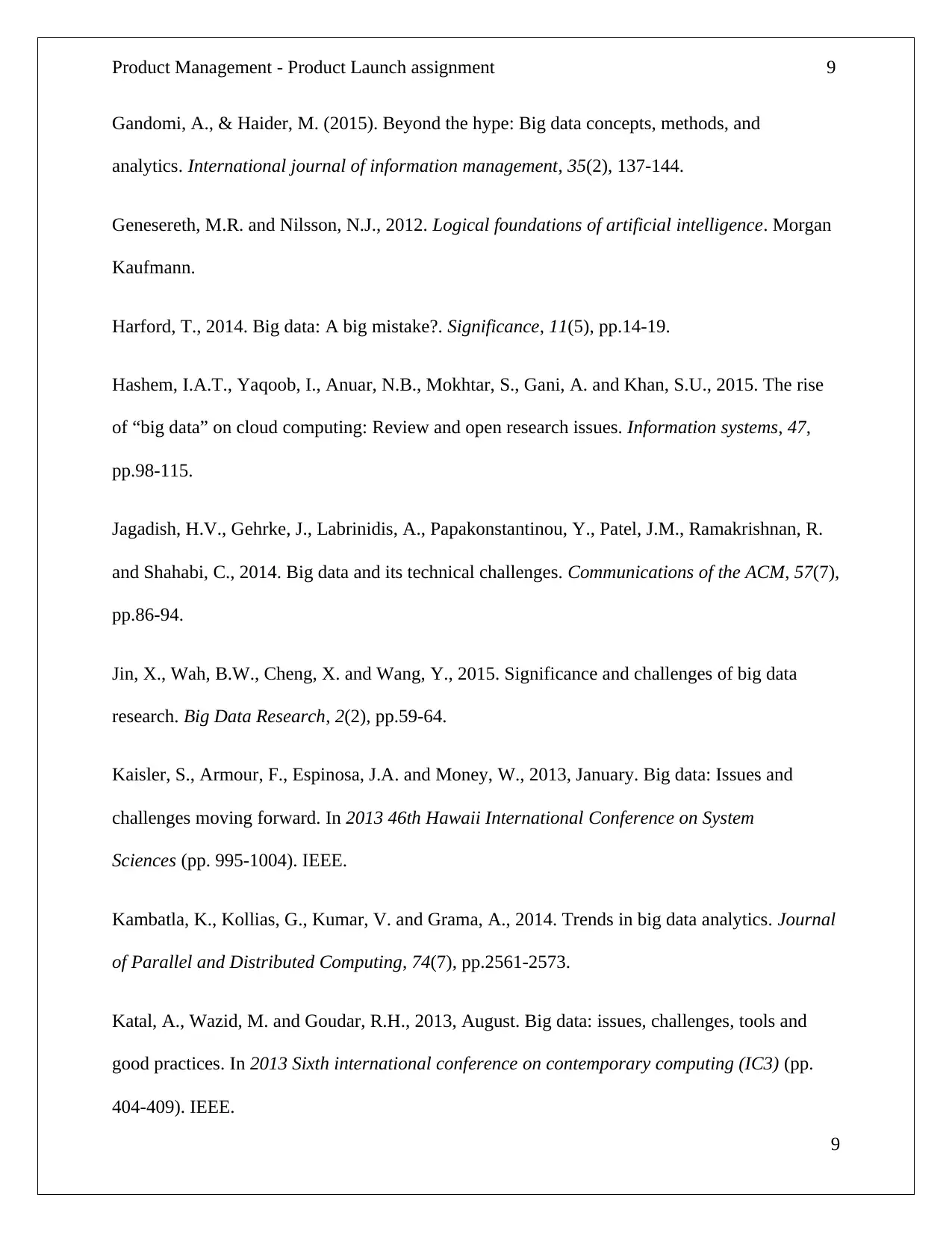
Product Management - Product Launch assignment 9
Gandomi, A., & Haider, M. (2015). Beyond the hype: Big data concepts, methods, and
analytics. International journal of information management, 35(2), 137-144.
Genesereth, M.R. and Nilsson, N.J., 2012. Logical foundations of artificial intelligence. Morgan
Kaufmann.
Harford, T., 2014. Big data: A big mistake?. Significance, 11(5), pp.14-19.
Hashem, I.A.T., Yaqoob, I., Anuar, N.B., Mokhtar, S., Gani, A. and Khan, S.U., 2015. The rise
of “big data” on cloud computing: Review and open research issues. Information systems, 47,
pp.98-115.
Jagadish, H.V., Gehrke, J., Labrinidis, A., Papakonstantinou, Y., Patel, J.M., Ramakrishnan, R.
and Shahabi, C., 2014. Big data and its technical challenges. Communications of the ACM, 57(7),
pp.86-94.
Jin, X., Wah, B.W., Cheng, X. and Wang, Y., 2015. Significance and challenges of big data
research. Big Data Research, 2(2), pp.59-64.
Kaisler, S., Armour, F., Espinosa, J.A. and Money, W., 2013, January. Big data: Issues and
challenges moving forward. In 2013 46th Hawaii International Conference on System
Sciences (pp. 995-1004). IEEE.
Kambatla, K., Kollias, G., Kumar, V. and Grama, A., 2014. Trends in big data analytics. Journal
of Parallel and Distributed Computing, 74(7), pp.2561-2573.
Katal, A., Wazid, M. and Goudar, R.H., 2013, August. Big data: issues, challenges, tools and
good practices. In 2013 Sixth international conference on contemporary computing (IC3) (pp.
404-409). IEEE.
9
Gandomi, A., & Haider, M. (2015). Beyond the hype: Big data concepts, methods, and
analytics. International journal of information management, 35(2), 137-144.
Genesereth, M.R. and Nilsson, N.J., 2012. Logical foundations of artificial intelligence. Morgan
Kaufmann.
Harford, T., 2014. Big data: A big mistake?. Significance, 11(5), pp.14-19.
Hashem, I.A.T., Yaqoob, I., Anuar, N.B., Mokhtar, S., Gani, A. and Khan, S.U., 2015. The rise
of “big data” on cloud computing: Review and open research issues. Information systems, 47,
pp.98-115.
Jagadish, H.V., Gehrke, J., Labrinidis, A., Papakonstantinou, Y., Patel, J.M., Ramakrishnan, R.
and Shahabi, C., 2014. Big data and its technical challenges. Communications of the ACM, 57(7),
pp.86-94.
Jin, X., Wah, B.W., Cheng, X. and Wang, Y., 2015. Significance and challenges of big data
research. Big Data Research, 2(2), pp.59-64.
Kaisler, S., Armour, F., Espinosa, J.A. and Money, W., 2013, January. Big data: Issues and
challenges moving forward. In 2013 46th Hawaii International Conference on System
Sciences (pp. 995-1004). IEEE.
Kambatla, K., Kollias, G., Kumar, V. and Grama, A., 2014. Trends in big data analytics. Journal
of Parallel and Distributed Computing, 74(7), pp.2561-2573.
Katal, A., Wazid, M. and Goudar, R.H., 2013, August. Big data: issues, challenges, tools and
good practices. In 2013 Sixth international conference on contemporary computing (IC3) (pp.
404-409). IEEE.
9
⊘ This is a preview!⊘
Do you want full access?
Subscribe today to unlock all pages.

Trusted by 1+ million students worldwide
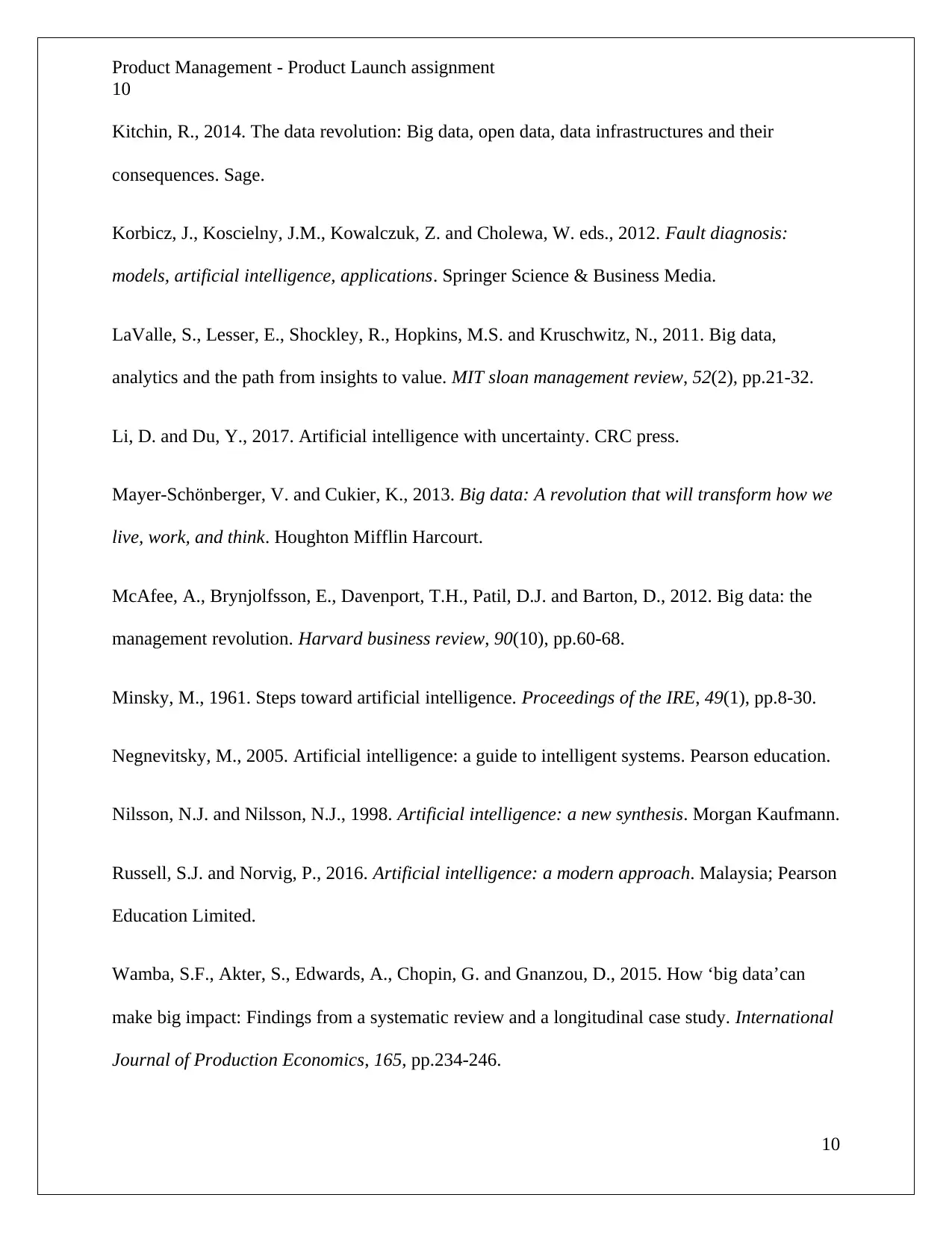
Product Management - Product Launch assignment
10
Kitchin, R., 2014. The data revolution: Big data, open data, data infrastructures and their
consequences. Sage.
Korbicz, J., Koscielny, J.M., Kowalczuk, Z. and Cholewa, W. eds., 2012. Fault diagnosis:
models, artificial intelligence, applications. Springer Science & Business Media.
LaValle, S., Lesser, E., Shockley, R., Hopkins, M.S. and Kruschwitz, N., 2011. Big data,
analytics and the path from insights to value. MIT sloan management review, 52(2), pp.21-32.
Li, D. and Du, Y., 2017. Artificial intelligence with uncertainty. CRC press.
Mayer-Schönberger, V. and Cukier, K., 2013. Big data: A revolution that will transform how we
live, work, and think. Houghton Mifflin Harcourt.
McAfee, A., Brynjolfsson, E., Davenport, T.H., Patil, D.J. and Barton, D., 2012. Big data: the
management revolution. Harvard business review, 90(10), pp.60-68.
Minsky, M., 1961. Steps toward artificial intelligence. Proceedings of the IRE, 49(1), pp.8-30.
Negnevitsky, M., 2005. Artificial intelligence: a guide to intelligent systems. Pearson education.
Nilsson, N.J. and Nilsson, N.J., 1998. Artificial intelligence: a new synthesis. Morgan Kaufmann.
Russell, S.J. and Norvig, P., 2016. Artificial intelligence: a modern approach. Malaysia; Pearson
Education Limited.
Wamba, S.F., Akter, S., Edwards, A., Chopin, G. and Gnanzou, D., 2015. How ‘big data’can
make big impact: Findings from a systematic review and a longitudinal case study. International
Journal of Production Economics, 165, pp.234-246.
10
10
Kitchin, R., 2014. The data revolution: Big data, open data, data infrastructures and their
consequences. Sage.
Korbicz, J., Koscielny, J.M., Kowalczuk, Z. and Cholewa, W. eds., 2012. Fault diagnosis:
models, artificial intelligence, applications. Springer Science & Business Media.
LaValle, S., Lesser, E., Shockley, R., Hopkins, M.S. and Kruschwitz, N., 2011. Big data,
analytics and the path from insights to value. MIT sloan management review, 52(2), pp.21-32.
Li, D. and Du, Y., 2017. Artificial intelligence with uncertainty. CRC press.
Mayer-Schönberger, V. and Cukier, K., 2013. Big data: A revolution that will transform how we
live, work, and think. Houghton Mifflin Harcourt.
McAfee, A., Brynjolfsson, E., Davenport, T.H., Patil, D.J. and Barton, D., 2012. Big data: the
management revolution. Harvard business review, 90(10), pp.60-68.
Minsky, M., 1961. Steps toward artificial intelligence. Proceedings of the IRE, 49(1), pp.8-30.
Negnevitsky, M., 2005. Artificial intelligence: a guide to intelligent systems. Pearson education.
Nilsson, N.J. and Nilsson, N.J., 1998. Artificial intelligence: a new synthesis. Morgan Kaufmann.
Russell, S.J. and Norvig, P., 2016. Artificial intelligence: a modern approach. Malaysia; Pearson
Education Limited.
Wamba, S.F., Akter, S., Edwards, A., Chopin, G. and Gnanzou, D., 2015. How ‘big data’can
make big impact: Findings from a systematic review and a longitudinal case study. International
Journal of Production Economics, 165, pp.234-246.
10
Paraphrase This Document
Need a fresh take? Get an instant paraphrase of this document with our AI Paraphraser

Product Management - Product Launch assignment
11
Xiaofeng, M. and Xiang, C., 2013. Big data management: concepts, techniques and challenges
[J]. Journal of computer research and development, 1(98), pp.146-169.
11
11
Xiaofeng, M. and Xiang, C., 2013. Big data management: concepts, techniques and challenges
[J]. Journal of computer research and development, 1(98), pp.146-169.
11
1 out of 11
Related Documents
Your All-in-One AI-Powered Toolkit for Academic Success.
+13062052269
info@desklib.com
Available 24*7 on WhatsApp / Email
![[object Object]](/_next/static/media/star-bottom.7253800d.svg)
Unlock your academic potential
Copyright © 2020–2025 A2Z Services. All Rights Reserved. Developed and managed by ZUCOL.





